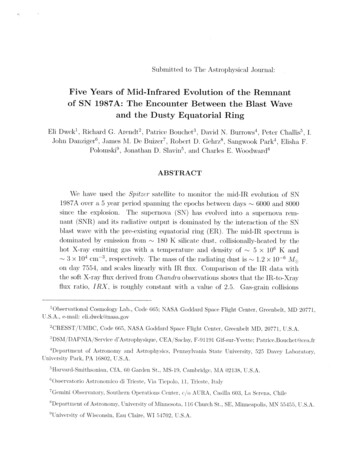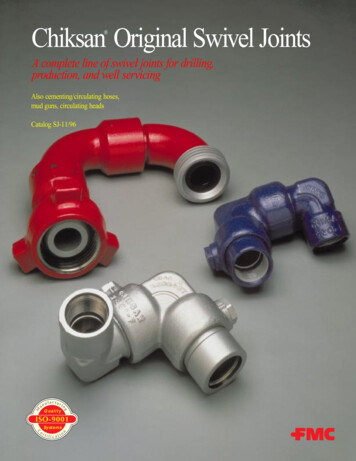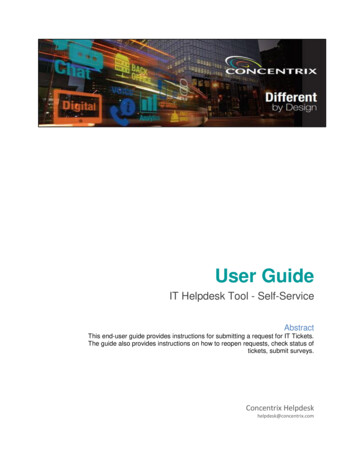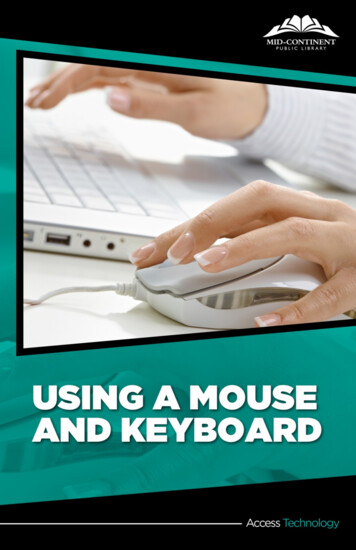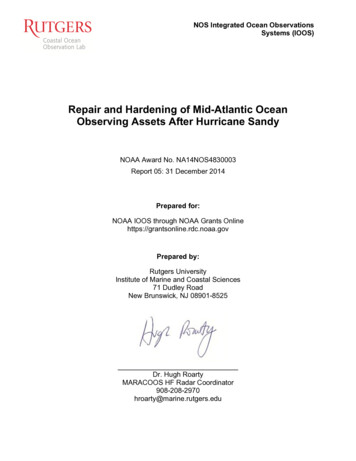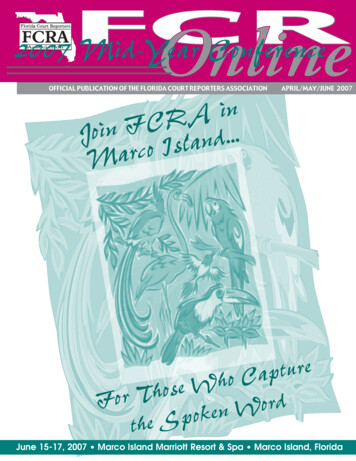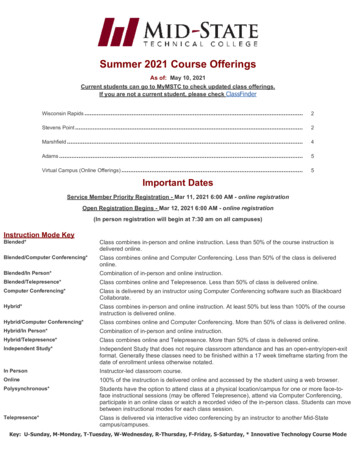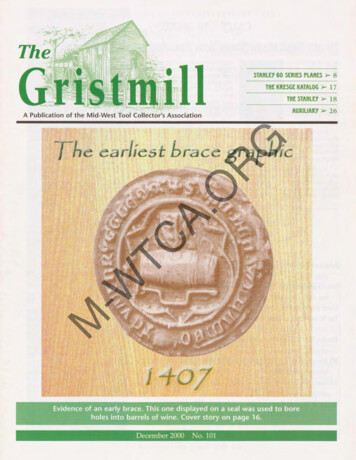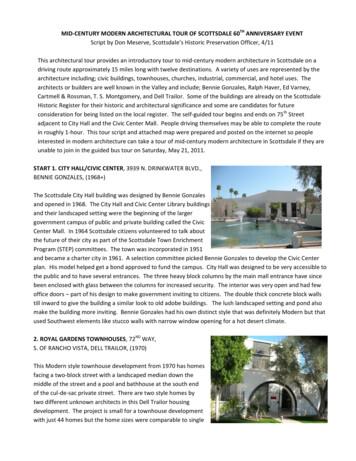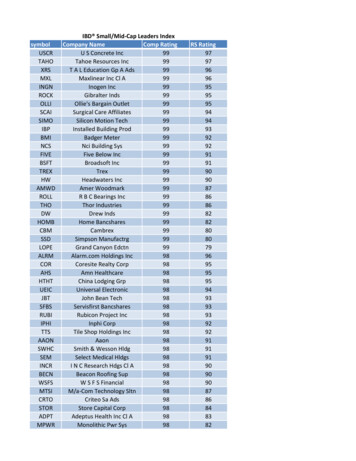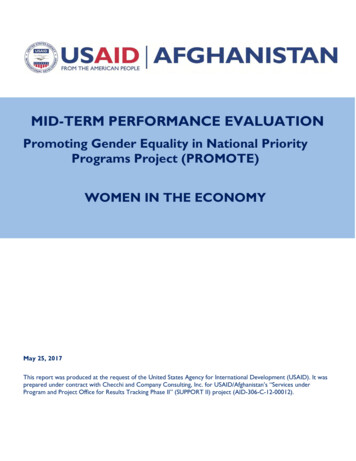
Transcription
MID-TERM PERFORMANCE EVALUATIONPromoting Gender Equality in National PriorityPrograms Project (PROMOTE)WOMEN IN THE ECONOMYMay 25, 2017This report was produced at the request of the United States Agency for International Development (USAID). It wasprepared under contract with Checchi and Company Consulting, Inc. for USAID/Afghanistan’s “Services underProgram and Project Office for Results Tracking Phase II” (SUPPORT II) project (AID-306-C-12-00012).
This report was contracted under USAID Contract Number: AID-306- C-12-00012: Services UnderProgram and Project Office for Results Tracking Phase II (SUPPORT II). This Activity was initiated by theOffice of Program and Project Development (OPPD) through Dr. Mohammad Sediq Orya, COR/SUPPORTII.Assignment Title: Mid-Term Performance Evaluation for Women In the Economy(WIE)Team Leader: Corinne Jane GriffithsEvaluation Start Date: December 3, 2016Completion Date: May 25, 2017Paul DeLucco, Chief of PartyWaheed Ahmadi, Deputy Chief of PartyChecchi and Company Consulting, Inc.Kabul, AfghanistanDisclaimer:The views expressed in this report are those of the author and do not necessarily reflect theviews of USAID, the Government of the Islamic Republic of Afghanistan, or any otherorganization or person associated with this project.i
TABLE OF CONTENTSACRONYMSiiiEXECUTIVE SUMMARY1PROJECT BACKGROUND8EVALUATION PURPOSE & QUESTIONS11EVALUATION DESIGN, METHODS & LIMITATIONS12Data Collection12Data Analysis Process13Limitations13FINDINGS, CONCLUSIONS, AND tions25ANNEXES28Annex I: Statement of Work28Annex II: Survey Instruments and Questionnaires42Annex III: List of Critical and Key Documents Reviewed64Annex IV: Schedule of Meetings and Sources of Information70Annex V: Notes from Key Interviews, Focus Group Discussions, and other Meetings75Annex VII: Disclosure of any Conflicts of Interest95ii
LIST OF TABLESTable 1: Status of High Value Skills TrainingTable 2: Highlights of Aghaez Consulting & AHG Selection Process1620LIST OF FIGURESFigure 1: WIE Program Map10iii
ACRONYMSACEAfghan Center for ExcellenceACCIAfghan Chamber of Commerce & IndustriesAHGAfghan Holding GroupAJNAfghan Jobs NowAMEPActivity Monitoring and Evaluation PlanAMAAfghanistan Microfinancing AssociationB2BBusiness-to-BusinessBDSBusiness Development ServicesBSPBusiness Service ProvidersCOContracting OfficerDoLSAMDDepartment of Labor, Social Affairs, Martyrs, and the DisabledFGDFocus Group DiscussionFINCAFoundation for International Community AssistanceGDAGlobal Development AllianceGIRoAGovernment of Islamic Republic of AfghanistanIAInternship and ApprenticeshipICTInformation and Communication TechnologyITInformation TechnologyJRTJob Readiness TrainingKMPKnowledge Management PortalKIIKey Informant InterviewLOPLife of ProjectM&EMonitoring and EvaluationMBAMasters in Business AdministrationMFIMicro Finance InstitutionsMoHRAMinistry of Haj and Religious AffairsMoLSAMDMinistry of Labor, Social Affairs, Martyrs, and the Disablediv
MOUMemorandum of UnderstandingM-PaisaMobile Money Phone App (ROSHAN)NAPNational Action PlanNOVE ONLUSItalian NGO (Support the Unsupported)PROMOTEPromoting Gender Equality in National Priority Programs ProjectPSAPublic Service AnnouncementPSDPrivate Sector DevelopmentRSIRahman Safi InternationalSearchPathRecruitment FirmSMESmall and Medium EnterprisesSMSShort Message Service, i.e. text messageSOWStatement of WorkSTTAShort Term Technical AssistanceTOCTheory of ChangeTWGTechnical Working GroupUSAIDUnited States Agency for International DevelopmentUSGUnited States GovernmentWIEWomen in the EconomyWIGWomen in GovernmentWLDWomen’s Leadership Development ProjectWfDWorkforce Developmentv
EXECUTIVE SUMMARYPROJECT BACKGROUNDIn 2015, USAID awarded a five-year1, 71 million contract (AID-306-TO-15-00062) to U.S.-basedinternational consulting firm DAI for the implementation of Women in the Economy (WIE), theeconomic and business component of Promoting Gender Equality in National Priority Programs(PROMOTE) project, the flagship program of USAID/Afghanistan in the promotion of genderequity and women’s empowerment through concerted long-term investment.The primary objective of WIE is to enable educated Afghan women to increase their participationin leadership in the formal mainstream economy by helping them secure employment withadvancement potential, and by improving the viability and income growth of women-ownedbusinesses with a ten percent or greater female workforce. WIE is helping women secureemployment with advancement potential through internships and apprenticeships and improvingthe viability and income growth of women-owned businesses.EVALUATION PURPOSE AND EVALUATION QUESTIONSThe purpose of the mid-term evaluation was to assess the effectiveness of the activities of Womenin the Economy (WIE) from the program’s inception in July 2015 to October 2016. The findingsand recommendations from this evaluation will be used to guide the remaining years of programimplementation through June 2019. More broadly, the evaluation will inform USAID programmingdecisions on approaches to increasing women’s presence and participation in the country’seconomy that will lead to women’s empowerment in Afghanistan. The evaluation conclusions areaimed at USAID, PROMOTE, and the WIE program management team. The evaluation questions:1. To what extent has WIE employment support resulted in employment for thebeneficiaries to date?2. Have WIE strategies and/or activities resulted in more woman-friendly workplaces? If so,which have been the most effective?3. How successful have the WIE entrepreneurship support interventions been in expandingbeneficiary businesses in terms of profit and the hiring of more staff/workers?4. Identify the program’s design and implementation strengths and weaknesses, as well asthe areas, if any, where WIE can improve results—for example, through collaborationwith other PROMOTE components.1A year into implementation, the life span of WIE was reduced to four years.1
5. Has the incorporation of technology, e.g., SMS information, “Search Path,” etc.,contributed to improved performance and results?METHODS USED IN THE EVALUATIONAs suggested in the Statement of Work (SOW), the evaluation team used a mixed-methodapproach utilizing both quantitative and qualitative analysis through document reviews, KeyInformant Interviews (KIIs), surveys, phone surveys, and Focus Group Discussions (FGDs).The mixed-method approach allowed for a wide range of consultations with key stakeholdersand partners. The evaluation, which took place over a period of six weeks, covered the five keyeconomic regions in which WIE is active: Mazar-i-Sharif, Kandahar, Jalalabad, Herat, and Kabul.The team randomly selected and completed phone surveys with 252 interns and apprentices froma list of 700 randomly selected beneficiaries from all five economic regions.It is early in the project cycle for a mid-term evaluation; WIE staff are still in the final stages oflaying the groundwork for the implementation of some of the long-term program activities andfinalizing contracts for several key partners. The number of beneficiaries who have alreadyreceived WIE support, and the overall impact of the program are, consequently, somewhatlimited.FINDINGSThe findings are formulated around the five questions asked by USAID, as discussed below:1. To what extent has WIE employment support resulted in employment for thebeneficiaries to date?According to the 2016 WIE Annual Report, 237 women were placed in jobs in the first year ofimplementation - lower than projected in the WIE Activity Monitoring and Evaluation Plan(AMEP) for Year 1, October 1, 2015 to September 30, 2016. It is important, however, to considerthe actions WIE management has taken to address the shortfall, notably the creation of a jobplacement pipeline to identify market demand, employer needs, and specific job opportunities. Thepipeline is based on interviews with businesses, Micro-Finance Institutions (MFIs), the healthcaresector, and a general market analysis that prompted several surveys. The WIE Technical WorkingGroup (TWG) completed two surveys, one in Information and Communication Technology(ICT), and a second one that considered females working in the retail sector. A “Medical ServicesStudy” is currently in progress. The “ICT Survey” identified opportunities in InformationTechnology (IT), media, and telecommunications. The “Female Participation in Retail Sector2
Survey” identified opportunities in sales. In addition to the job placement pipeline initiative, staffmembers of other WIE components are preparing to launch activities linked to SearchPathAfghanistan, Jobs.af, Nove Onlus, Afghan Micro Finance Association, and High Value SkillsTraining; these activities will overlap with an aggressive marketing campaign to accelerate jobplacement. It is also important to look at the conversion rate of interns to job placement; a surveyof 322 interns reported 22 percent job placement in long-term positions. WIE staff project aconversion rate of 35 percent in 2017.2) Have WIE strategies and/or activities resulted in more women friendlyworkplaces? If so, which have been the most effective?WIE implements a rigorous vetting process for businesses asking to host interns, which hasresulted in 98 percent of the interns placed reporting that they work in a women-friendlyworkplace, as verified by WIE’s monitoring and evaluation (M&E) data. The remaining two percentreport dissatisfaction based on a mix of male harassment, access to bathrooms, and overallfeelings of safety. WIE has partnered with the Government of the Islamic Republic of Afghanistan(GIRoA) by co-branding beneficiary registration forms, scholarship applications, and employerdata collection with the Ministry of Labor, Social Affairs, Martyrs and the Disabled (MoLSAMD).The Deputy Ministry of Administration and Finance of the Ministry of Haj and Religious Affairs(MoHRA) has also committed to support WIE by raising public awareness throughmasjids/mosques, conferences, printed articles, and workplace-related activities. WIE’s TechnicalServices Group (TSG) is working with its partner, Rumi Consulting, in developing a culturallysensitive messaging campaign that will focus on sensitizing businesses and the community at largeabout the acceptance of women in the workforce without the fear of harassment or their safetythreatened. The Theory of Change (TOC) takes time to play out, and with the WIE programbeing cut by one year, it will be even more challenging to achieve sustainable, measurable impactin the promotion of female-friendly workplaces within the Life of Project (LOP).3) How successful have the WIE entreneurship support interventions been inexpanding beneficiary businesses in terms of profit and the hiring of morestaff/workers?It is too soon to assess whether WIE interventions have helped businesses to increase profits orresulted in the hiring of more women. WIE’s M&E team is just now starting to establish financialbaselines; according to Rahman Safi International (RSI), WIE’s M&E subcontractor, it takes timeto build trust with each business before they will share accurate financials. A weakness in themajority of businesses in Afghanistan is the lack of professional management. Businesses are oftenfamily run, and managers often lack the skills to grow businesses to the next level and increaseprofits. WIE’s Private Sector Development (PSD) component is addressing this issue by linking3
businesses with local Business Service Providers (BSPs) such as finance, marketing, tax lawconsultants, etc., and also offering Master of Business Administration (MBA) embeds. It is a slowprocess, shifting businesses from a “donor mindset” to seeing the value of paying for outsideservices while facing a more realistic economy. The PSD component’s ability to capture andcommunicate success stories from businesses that have benefited from these services will helpto accelerate program recognition and results.4) Identify project’s design and implementation strengths and weaknesses, as well asthe areas (if any) where WIE can improve results – for example, throughcollaboration with other PROMOTE components.A key strength of the WIE program is its multi-prong approach to increasing women’sparticipation in the economy by working with a large variety of stakeholders including job seekers,the business community, MFIs, business incubators, schools, and the government. WIE High ValueSkills Training is focused on growth sectors of the job market like ICT, media, and health care.The Job Readiness Training (JRT) is practical and culturally sensitive; it prepares women to enterthe workforce, empowered to identify and manage job opportunities with confidence. Selfefficacy (Pre- and Post-Training) is monitored by WIE M&E staff. The partnerships with MFIs,involving the training of female loan officers who can in turn assist women-owned business ingetting loans will result in more loans to women. The two main obstacles to growing a businessto the next level are lack of professional management and access to finance. WIE has organizeda strong approach to address these obstacles through links with BSPs, MBA embeds, and loanreferral services. Entrepreneurs are the engine of growth and job creation, and WIE haspartnered with two business incubators, Aghaez Consulting and Afghan Holding Group (AHG),which provide complementary strategies in the development of entrepreneurs.WIE management has been challenged in finding qualified candidates for internal staff positions local and international - which has weakened and slowed progress. Losing a year from theprogram, while taking on an additional 7,500 beneficiaries through President Ghani’s Afghan JobsNow initiative, has stretched staff resources and contributed to slower progress in areas like PSD.WIE’s community outreach and program promotion has also been slow and narrow in its rollout.The entrepreneur incubator concept is strong but narrow in its definition of “entrepreneur.”During interviews with WIE regional staff, it became apparent they were focused on the numbers;getting qualitative feedback has been a challenge for the evaluation team, a challenge which mightbe linked to WIE’s quantitatively focused M&E approach. Lastly, for a program focused on women,there is weak representation of women in the WIE senior management team; the Chairman ofthe Technical Working Group (TWG) is a man, which sends a weak signal to the greatercommunity.4
WIE’s ongoing collaboration with other PROMOTE components and the Afghan government isactive and appropriate. According to the 2016 annual report:The eastern regional WIE office met with Women in Leadership (WLD) to shareinformation and look at areas to support in each other’s programs. WLD and WIE willsupport each other by referring applicants who fit the other’s criteria. The KnowledgeManagement Portal (KMP) team met with Women in Government (WIG) to demonstratethe KMP and discussed the possibility of customizing the same system for WIG. The WIEEastern Regional Manager held a coordination meeting with the Public-Private PartnershipCoordinator for the USAID-funded Chemonics Early Grade Reading project. They agreedto hold regular coordination meetings and to inform their beneficiaries of the WIEprogram.5) Has the incorporation of technology (e.g. SMS information, “Search Path”)contributed to improved performance and results?Since the project’s inception, there has been broad-based use of technology throughout theproject. SMS has been essential in overall communications and program messaging within thenetwork of beneficiaries. The use of the M-Paisa (ROSHAN) mobile money transfer service helpsWIE manage payments to interns, apprentices, and scholarship recipients in a timely and accuratemanner. The recent introduction of a biometrics fingerprinting system already shows evidence ofhalting fraudulent registrations while providing WIE with the ability to track and monitorbeneficiaries throughout the system. The Knowledge Management Portal (KMP), a databasedriven web application, incorporates an online registration system for job seekers, interns, andpotential employers, providing up-to-date information by district, province, and region toimprove job placement opportunities and track M&E reporting. The Muhafiz mobile application,a tool developed by two Code Challenge winners, reports street harassment. Although not anoriginal deliverable, WIE has recognized that the Muhafiz application brings together the use oftechnology and support for the safety of women going to and from work - key deliverables - andshould be marketed accordingly. The on-line SearchPath, when it is implemented, will train, coach,and mentor women through the job search process. The KMP link with Jobs.af will provide thebest on-line job search platform for women job seekers.CONCLUSIONSA relatively low number of women have been placed in jobs to-date through the WIE activity.Since the evaluation took place early in the life of the project, it was critical to identify accelerationpoints in the program for job placement. The job placement pipeline (High Value Skills Training);functioning partners, e.g. Jobs.af and Searchpath; a focus on PSD; and an aggressive program5
marketing plan, will combine to accelerate job placements through the life of the project andbeyond. The rate of internships converting to permanent employment is also expected toincrease.Setting the age cap for job placement candidates at 30 years prevents WIE from drawing on alarger pool of women with the job and management experience that is in demand. Older women,if placed in managerial roles, would be positioned to accelerate the hiring of younger women,advocate for them, and mentor them within the workplace.The expected employment of 21,000 women over the life of the activity is unrealistic consideringthat the Afghan economy is shifting away from donor dependence and has projected GDP growthof only 1.8 percent in 2017 (World Bank). WIE faces daunting targets. The acceptance of womenin the workforce relies heavily on GIRoA and cultural acceptance that can only be achieved bysustained efforts over time. The reduction of the project’s period of performance will inhibit itspotential for long-term impact on the acceptance of women in the workforce, including fosteringwomen-friendly workplaces.WIE’s approach of having beneficiary businesses invest their own money into inputs normallyprovided by donors is both more sustainable and more appropriate considering the decrease inavailable funding.The expansion of profits and hiring ability of WIE’s beneficiary businesses cannotbe assessed until a baseline is recorded. Measuring change will require time since WIE will needto develop trusting relationships before businesses will permit close inspection of their financials.The WIE project’s key strength is a demand-driven systems approach, designed to establish asustainable network of partners, e.g., a connected business network; an informed public regardingwomen in the workforce; professionally-run businesses; a community of entrepreneurs; and,most importantly, a confident trained workforce of women. The result of the project’s work willbe the formulation and strengthening of relationships supportive of this purpose that will sustainand scale the impact. Partners like Rumi Consulting, Nove Onlus, and ACE will be linked withintheir respective areas of expertise to a network of potential clients and users. A trainedworkforce and support to entrepreneurs should combine to encourage job creation andemployment opportunities. The use of technology in the WIE project also allows for agile, robust,project implementation and precise M&E.The time remaining to the project is a major weakness affecting various components. Thetimeframe of community outreach and promotion should be reevaluated based on the shortene
May 25, 2017 · 1 EXECUTIVE SUMMARY PROJECT BACKGROUND In 2015, USAID awarded a five-year1, 71 million contract (AID-306-TO-15-00062) to U.S.-based international consulting firm DAI for the implementation of Women in the Economy (WIE), the economic and business component of Promoting Gender Equality in National Priority Programs (PRO

